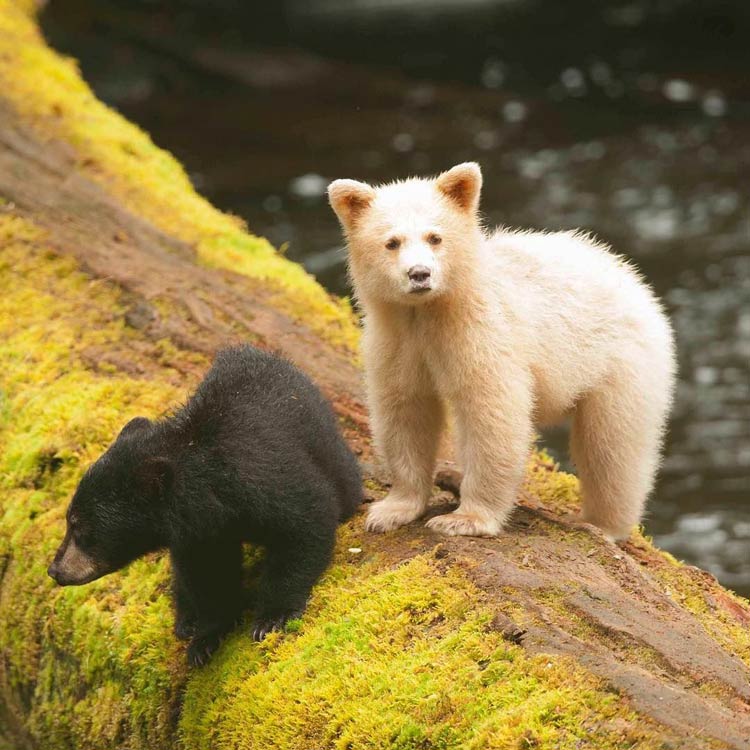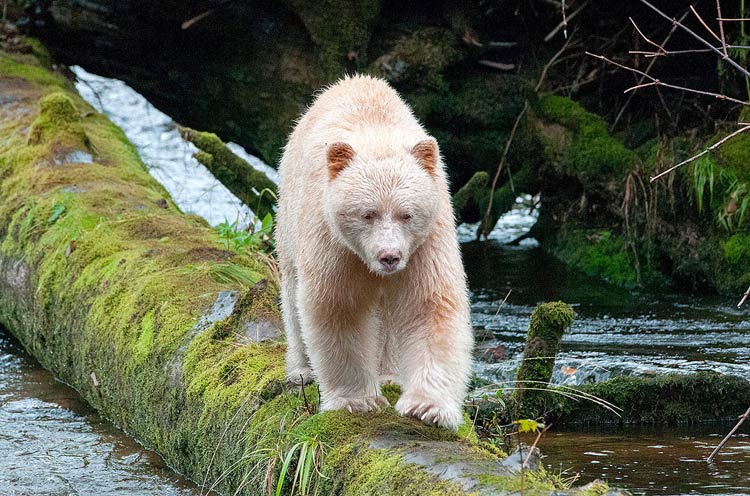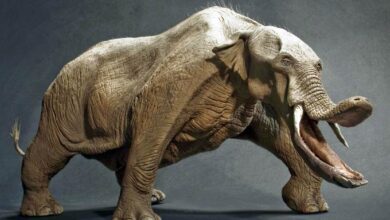Kermode Bears: Guardians of the Rainforest
The Ursus americanus kermodei, also known as the Kermode bear or spirit bear, is a subspecies of the American black bear that is found in certain parts of British Columbia, Canada. It is known for its distinctive white or cream-colored coat, which is caused by a genetic mutation that occurs in about one in ten black bears in the region. The Kermode bear is a rare subspecies, with an estimated population of around 250 individuals in the wild.
Kermode bears are similar in size and behavior to other black bears, but they are generally lighter in weight and have shorter fur. They are omnivorous and feed on a variety of plants, berries, insects, and small animals. Like other black bears, they are skilled climbers and are active during the day and at night.
The Kermode bear is considered a cultural and spiritual symbol by many indigenous peoples of the region and is protected under Canadian law. It is an important part of the ecosystem in which it lives, playing a role in seed dispersal and helping to shape the landscape through its feeding and movement patterns.

Taxonomy
The complete taxonomic classification for the Kermode bear is Ursus americanus kermodei within the family Ursidae, order Carnivora, class Mammalia, phylum Chordata, and kingdom Animalia. This classification places the Kermode bear within the broader category of bears, specifically as a subspecies of the American black bear (Ursus americanus)
- Kingdom: Animalia
- Phylum: Chordata
- Class: Mammalia
- Order: Carnivora
- Family: Ursidae
- Genus: Ursus
- Species: Ursus americanus
- Subspecies: Ursus americanus kermodei
Description
The Kermode bear is a large, muscular animal with a distinctive white or cream-colored coat, which is caused by a genetic mutation that occurs in about one in ten black bears in the region.
Kermode bears are similar in size to other black bears, with adult males weighing between 150 and 250 kilograms and adult females weighing between 100 and 135 kilograms. They have a round, broad head, small ears, and a short, pointed snout. Their fur is shorter and lighter than that of other black bears, and they have a distinctive white or cream-colored coat that makes them easy to distinguish from other bears.
Kermode bears are omnivorous and feed on a variety of plants, berries, insects, and small animals. They are skilled climbers and are active during the day and at night. They are generally solitary animals, although they may come into contact with other bears during the breeding season or when food is scarce. Kermode bears are found in forests, where they den in hollow trees or under fallen logs. They are generally shy and avoid contact with humans, but they can be dangerous if provoked or if they feel threatened.

Distribution and habitat
The Kermode bear is found in certain parts of British Columbia, Canada. It is native to the central and north coast regions of the province, as well as some of the islands in the area.
Kermode bears are found in a variety of forested habitats, including coniferous forests, mixed forests, and coastal rainforests. They prefer areas with abundant food sources, such as berry patches and streams with salmon runs. They are also found in areas with good den sites, such as hollow trees or under fallen logs.
Kermode bears are adapted to living in a variety of climatic conditions, including cold winters and wet, mild summers. They are found at elevations ranging from sea level to high mountains, and they are able to survive in a variety of forested habitats. However, they are sensitive to habitat disturbance and are more likely to be found in areas with low human activity.

Ecology and behaviour
Kermode bear is an omnivorous animal that feeds on a variety of plants, berries, insects, and small animals. Its diet varies depending on the season and the availability of food sources, and it is known to feed on salmon during the spawning season.
Kermode bears are generally solitary animals, although they may come into contact with other bears during the breeding season or when food is scarce. They are active during the day and at night and are skilled climbers, often climbing trees to feed on berries or to escape predators. They are generally shy and avoid contact with humans, but they can be dangerous if provoked or if they feel threatened.
Kermode bears play an important role in the ecosystem in which they live. They help to disperse seeds through their feces and through the movement of their bodies, and they shape the landscape through their feeding and movement patterns. They are also an important food source for predators such as wolves and grizzly bears.
Kermode bears are threatened by habitat loss and degradation, as well as human activities such as hunting, logging, and development. They are protected under Canadian law and are considered a cultural and spiritual symbol by many indigenous peoples of the region.

Reproduction and parenting
Female Kermode bears reach sexual maturity at around the age of 4 or 5, while males reach sexual maturity at around the age of 5 or 6. The breeding season for Kermode bears typically occurs from May to July, although it can vary depending on the region and the availability of food. During the breeding season, males roam widely in search of females and may travel long distances to find them.
Female Kermode bears generally give birth to one to three cubs every two to three years, after a gestation period of about 220 days. The cubs are born in a den, where they remain with their mother until they are about 18 months old. During this time, the mother provides them with food and protection and teaches them the skills they need to survive on their own.
Male Kermode bears play no role in the parenting of their offspring and generally have no contact with their cubs. Once the cubs are old enough to fend for themselves, they leave their mother and set out on their own.

Captivity
It is a rare and protected species, and it is illegal to keep Kermode bears in captivity in Canada.
In general, it is not recommended to keep wild animals in captivity, as they may suffer from poor physical and mental health due to a lack of space, stimulation, and natural behaviors. Captive animals may also be at risk of injury or illness due to poor living conditions or inadequate care.
If you are interested in learning about bears or supporting their conservation, there are many ways you can do so without keeping one in captivity. Some options include visiting a bear sanctuary or wildlife rehabilitation center, supporting conservation organizations that work to protect bear habitats and populations, and learning about ways to reduce your impact on the environment and minimize your impact on bear habitats.

Interactions with humans
Interactions between Kermode bears (Ursus americanus kermodei) and humans can vary, but in general, these bears tend to be shy and avoid contact with people. Here are some key points regarding their interactions with humans:
- Shyness and Avoidance
Kermode bears, like many bears, are typically shy and will often avoid human contact if given the chance. They have a natural fear of humans, and their behavior is usually to retreat or move away when they detect human presence. - Human-Bear Conflict
While Kermode bears may try to avoid humans, conflicts can still occur. This is often related to factors such as food availability, human activities encroaching on bear habitat, or accidental encounters. It’s crucial for humans to take precautions, such as securing food and waste to prevent attracting bears, and for people in bear country to be aware of their surroundings and take appropriate safety measures. - Conservation and Protection
Kermode bears are protected under Canadian law, and hunting them is illegal. Conservation efforts are in place to protect their habitats and ensure the survival of this rare subspecies. There are also educational programs to raise awareness about the importance of coexisting with bears and minimizing negative interactions. - Tourism
In some areas where Kermode bears are found, particularly in the Great Bear Rainforest in British Columbia, there is eco-tourism focused on bear viewing. This allows people to observe bears in their natural habitat from a safe and respectful distance, contributing to local economies and raising awareness about the importance of conservation.

Conservation
Kermode bears are threatened by habitat loss and degradation, as well as human activities such as hunting, logging, and development. Their population is small, with an estimated 500 individuals remaining in the wild.
There are several organizations and initiatives working to protect Kermode bears and their habitats. These efforts include habitat conservation and restoration, research on the biology and ecology of Kermode bears, and education and outreach to raise awareness about the importance of bear conservation.
If you are interested in supporting Kermode bear conservation, there are several ways you can get involved. You can donate to organizations that work to protect bear habitats and populations, learn about ways to reduce your impact on the environment, and support sustainable land use practices that minimize the impact on bear habitats. You can also educate others about the importance of bear conservation and the threats facing Kermode bears.

Detailed data / dimensions (size)
Kermode bear, spirit bear (Ursus americanus kermodei)
The specific dimensions and data for the Kermode bear, can vary, and information may not be as readily available or precise as for some other more extensively studied species.
- Height on two paws: 180 cm (5.9 ft)
- Height at the Withers:
- Males: 105 cm (3.45 ft)
- Females: 70 cm (2.3 ft)
- Weight:
- Males: up to 225 kg (496 lb)
- Females: 135 kg (298 lb.
- Lifespan: In the wild, Kermode bears typically live around 15 to 25 years, although the lifespan can vary based on environmental factors and human-related threats.
- Max Speed: American black bears, including Kermode bears, are not known for their speed. They can run at speeds of up to 30 miles per hour (48 kilometers per hour) for short distances.
- Population: 400-1,100 (250 in the wild)

Kermode bear in culture
The Kermode bear, also known as the spirit bear, holds significant cultural and spiritual importance, particularly among indigenous peoples in the region where these bears are found, such as the First Nations in British Columbia, Canada. Here are some aspects of the cultural significance of the Kermode bear:
- Spiritual Symbolism
The Kermode bear is often considered a sacred or spiritual symbol. In some indigenous cultures, it is believed that these bears have a special connection to the spirit world. The white coat of the Kermode bear is sometimes associated with purity and the supernatural. - Cultural Stories and Myths
Indigenous communities often have stories, myths, and oral traditions that involve the Kermode bear. These stories can vary among different First Nations and may include teachings about respect for nature, coexistence with wildlife, and the importance of living in harmony with the environment. - Guardian Spirit
In some traditions, the Kermode bear is seen as a guardian spirit or a symbol of good fortune. The appearance of a spirit bear is considered a powerful and positive sign. - Ceremonial Use
The Kermode bear and its imagery may be incorporated into ceremonies, rituals, and traditional art forms. This can include masks, carvings, and other artistic representations. - Conservation Stewardship
The cultural significance of the Kermode bear has played a role in conservation efforts. Indigenous communities, recognizing the importance of these bears in their cultural heritage, have been actively involved in conservation initiatives to protect the habitats of Kermode bears. - Tourism and Education
The presence of the Kermode bear has also become a focal point for ecotourism and environmental education. People from various backgrounds come to the Great Bear Rainforest to witness these unique bears in their natural habitat, contributing to awareness about the need for conservation.
Understanding and respecting the cultural significance of the Kermode bear is vital for fostering positive relationships between indigenous communities, conservation efforts, and the broader public. It highlights the interconnectedness of cultural heritage, wildlife conservation, and environmental stewardship.

Interesting facts about the Kermode bear (spirit bear)
- The Kermode bear is a subspecies of the American black bear that is found in certain parts of British Columbia, Canada. It is known for its distinctive white or cream-colored coat, which is caused by a genetic mutation that occurs in about one in ten black bears in the region.
- The Kermode bear is a rare subspecies, with an estimated population of around 500 individuals. It is considered a cultural and spiritual symbol by many indigenous peoples of the region and is protected under Canadian law.
- Kermode bears are omnivorous and feed on a variety of plants, berries, insects, and small animals. They are skilled climbers and are active during the day and at night.
- Female Kermode bears generally give birth to one to three cubs every two to three years, after a gestation period of about 220 days. The cubs are born in a den, where they remain with their mother until they are about 18 months old.
- Kermode bears play an important role in the ecosystem in which they live, helping to disperse seeds and shaping the landscape through their feeding and movement patterns. They are also an important food source for predators such as wolves and grizzly bears.
- Kermode bears are threatened by habitat loss and degradation, as well as human activities such as hunting, logging, and development. Conservation efforts are underway to protect these bears and their habitats.

Recommended
- Grizzly
- Brown bear
- Kodiak bear
- Kamchatka brown bear
- American black bear
- Asian black bear
- Spectacled bear
- Sun bear
- Panda bear
- Polar bear
- Short-faced bear
- Cave bear
- Fastest animals
- Fastest birds


















